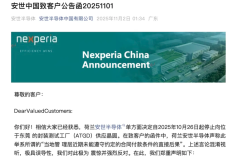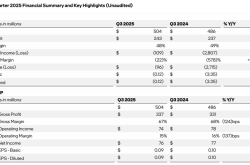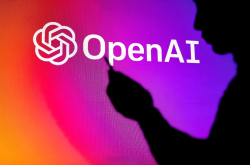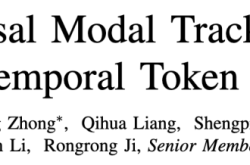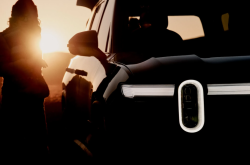Combating AI-Generated "Fake Photos": Have Taobao and Others Reached Their Limit?
![]() 04/10 2025
04/10 2025
![]() 561
561
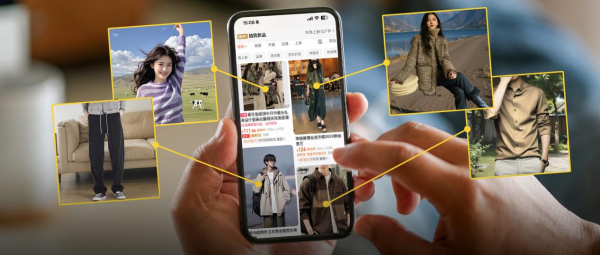
"Visual Fraud" Continues to Evolve
By / Meng Huiyuan
Edited by / Chen Dengxin
Typeset by / Annalee
As Taobao leads the charge in a large-scale crackdown on AI-generated fake photos, will the quality of goods consumers receive from online shopping improve in the future?
Undeniably, leveraging the platform's power to intercept AI fake photos at the source is the swiftest way to see tangible results.
With the low-threshold application of AI technology, this low-cost infringement model continues to fuel the unchecked proliferation of inferior products. By synthesizing images using AI, unscrupulous merchants can swiftly create "exquisite" product images or even mass-steal original designs, significantly reducing the costs associated with image theft and counterfeiting. For instance, some clothing merchants merely change the background and model using AI to pass off original designs as "identical styles across the entire network".
Taobao's ban on AI fake photos, as a platform, undoubtedly serves as a strong deterrent for these merchants. To date, Taobao has intercepted nearly 100,000 excessively Photoshopped or AI-exaggerated fake photos.
However, the widespread proliferation of AI fake photos fundamentally stems from the long-standing issue of image distortion in the e-commerce industry, albeit in a different form from previously heavily edited photos. More crucially, the inherent limitations of single-platform governance make it challenging to transform the already degraded e-commerce content ecosystem.
From Heavily Edited Photos to AI Creations
"I fell for it last month! The 'wool coat' in the AI photo looked super high-quality, but what I received was actually a polyester blend!"
"Many equate AI-generated images with merchant Photoshopping. No matter how much a merchant Photoshops, it's still within the same dimension. Moreover, when hiring models, it's impractical to produce only one heavily edited photo that's unrecognizable. With multiple photos, consumers can generally perceive fabric, color, etc., unlike AI-generated materials that are too perfect to be realistic. What's the difference from using concept art to deceive people into placing orders? No matter how well the image is generated, if it can't be realized in the real world, what's the point?"
"It's becoming increasingly difficult to distinguish AI images with the naked eye. Merchants who take actual photos typically have multiple angles or camera positions for models. Most early AI images were just single images, reused in videos, with models always in the same pose and not showing their faces. But now, AI is no longer limited to generating flat images; it can fully create 3D or multi-dimensional images."

Image source: Xiaohongshu
Despite the prominent issue of AI fake photos, the problem of goods not matching descriptions has actually existed in the e-commerce field for many years. It can even be said that consumers have long suffered from image distortion.
From the prevalent "seller's show" of early years to the "magically modified show" fueled by the proliferation of AI fake photos, the problem of images not matching actual products appears to be a technological advancement by merchants, shifting from Photoshopping to AI. This has sparked a new wave of massive negative reviews and returns. In reality, it's a commonly used trick by unscrupulous merchants, with the latter being more extreme than the former.
According to Taobao's ban on AI fake photos, an increasing number of seemingly exquisite but severely "mismatched" AI fake photos are flooding various platforms, misleading consumers and affecting shopping experiences. AI fake photos further reduce the cost for unscrupulous merchants to copy styles and steal images across platforms, infringing on the legitimate interests of original brands and merchants, and deteriorating the industry environment.

Taobao's Ban on AI Fake Photos
From the consumer perspective, a typical case involves the image recognition function of e-commerce platforms, combined with AI fake photos and pre-sale models.
Some consumers have reported that AI fake photos in the women's clothing section are now very exaggerated, with a single sample image being able to search for multiple similar product links. Even though titles, prices, materials, and other descriptions vary, the AI image tends to be almost identical. Some merchants try to circumvent platform plagiarism checks through minor AI adjustments (such as changing clothing colors, adding watermarks, etc.), but the product pages remain highly similar.
Behind this appearance lies the harsh reality of unscrupulous merchants using AI for low-cost image editing, squeezing the living space of compliant enterprises. AI fake photos reduce the cost for illegal merchants to plagiarize across platforms, discouraging good merchants who invest in original designs and spend money on hiring models to take actual product photos, ultimately leading to a situation where bad money drives out good.
Crucially, for many women's clothing items that adopt a pre-sale system, merchants will first use AI to create images to gauge whether budget orders have met the expected value. If they have, they will then contact the factory for production. If not, they will cancel all orders.
In this scenario, regardless of whether the pre-sale item will be converted into a physical product and smoothly delivered to the user, it will be a decisive blow. "Producing based on AI images will most likely result in a finished product that differs from the image effect. Even if the buyer receives it, they won't be satisfied. If the orders do not meet expectations, even if the money is refunded to the consumer, it's equivalent to everyone being deceived into contributing sales data for the merchant, and waiting in vain for so long."
The root of the above problems lies in the fact that when consumers are misled by AI fake photos and receive goods that completely do not meet their psychological expectations, they will inevitably feel deceived and have stepped on a landmine, ultimately leading to either applying for returns and refunds and leaving negative reviews, or directly losing trust in the e-commerce platform associated with the product.
To put it more bluntly, if AI images were indistinguishable from real images, no one would care whether they are generated by AI. Merchants and platforms are acutely aware that buyers only care whether the physical product received matches the online image.
The Root Lies in the Entire E-commerce Content Ecosystem
"This is also part of Taobao's platform governance. A while ago, we cracked down on malicious wool party members and some malicious store clusters. These are all actions to optimize the business environment in order to protect the rights and interests of consumers and merchants."
Regarding the current action to vigorously crack down on AI fake photos, a Taobao representative told Xin Kedu that this move is to guide merchants to operate in compliance. "We actually hope that everyone can recognize that Taobao is the first to tackle industry maladies and then lead the entire industry back to quality competition or healthy competition."
This also indirectly confirms how rampant AI fake photos have become. From the platform's perspective, using cases and data to illustrate the adverse consequences of AI fake photos is more intuitive.

Common AI Fake Photos in Online Shopping
"This Tmall store stole our images. We complained about them stealing our images using portrait rights, but now we see that they are avoiding it by using AI face-swapping. Does the platform allow their operations in this situation?" "Now there are AI-generated images on the platform, and there is even more image theft now. They directly steal our images to generate AI images, and now we can't even complain even if we have the original images?" "My images were modified using AI by peers to publish products. Why wasn't my complaint approved? The human eye can recognize that the hairstyles and poses in the images are the same, and it was modified based on my images..." Many original merchants claim that unscrupulous merchants use AI to steal product images in bulk at low cost, imitating popular products.
"The model image was directly used after the background was changed using AI, and the price was even lower, but their sales were higher than ours." Said the head of an original men's wear brand. Other merchants have reported that when complaining about model image infringement using portrait rights, the other party continues to steal images through AI face-swapping, with extremely high costs for rights protection.
Therefore, to implement rectification actions that can cover the entire industry, it still needs to rely on the power of the platform.
According to the relevant person in charge of Taobao, the platform will clearly identify typical scenarios of AI fake photos such as "material or style mismatch", "effect distortion or exaggeration", "non-existent scenes leading to product distortion", and "obvious distortion of cut-and-paste images", and launch recognition models. Through measures such as "source interception", "inventory clean-up", and "identification reminders", a comprehensive governance of AI fake photos on the platform will be conducted.
Specifically, at the product posting end, distorted images are detected and intercepted in real-time. Additionally, an AI synthesis prompt will be added to the product detail page to protect consumers' right to know. As of now, the platform has intercepted nearly 100,000 excessively Photoshopped or AI-exaggerated fake photos.
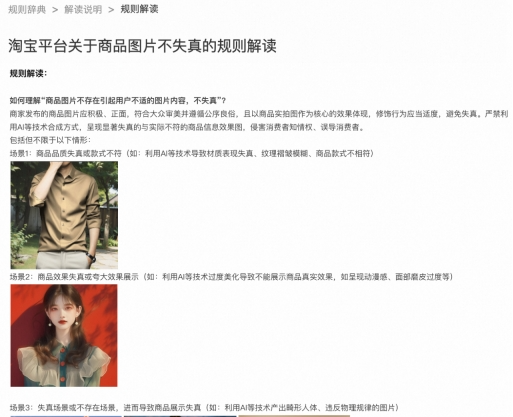
Taobao and Tmall Update the Interpretation of the Rule "Product Images Should Not Be Distorted"
However, from the relevant evaluations of this action in the public opinion field, it is not difficult to see that some consumers and merchants have a certain misunderstanding of the platform's new regulations.
"The spring of photographers is coming, because the system will also identify renderings as AI-generated." "AI is just a target; didn't Photoshop normally edit images before AI?" "3D fake images should also be banned! Especially for furniture and appliances, the goods received do not match the description." "The main focus is on fake images; AI is just one of the popular methods now"... Such views are not uncommon.
This further reflects that this wave of AI fake photo crisis is actually a systematic challenge faced by the current e-commerce content ecosystem, and its harm has permeated multiple levels such as consumer rights, merchant competition order, and healthy industry development.
"Even if AI fake photos are stopped, if the physical product quality is poor, it is destined to feel inferior when received. This has little to do with how the fake photo is presented." As a consumer said, "Don't some images also indicate that everything is subject to the physical product? So the main thing is to improve the honesty of the store. Otherwise, no matter how much rectification is done, it's just changing the form but not the essence."
From this perspective, the limitations of single-platform governance are evident: issues such as cross-platform image theft, algorithmic traffic bias, and low-priced inferior products still require industry collaboration.
Just as Taobao's initiative to the entire industry, only by establishing unified AI usage norms (such as prohibiting the forgery of material certificates) and improving the rapid complaint mechanism for image theft can the abuse of technology be fundamentally curbed, and e-commerce be pushed back onto the right path of quality competition.
But this is destined to require the joint participation of platforms, merchants, regulatory authorities, and consumers to reconstruct a new e-commerce content ecosystem centered on authenticity and originality.


